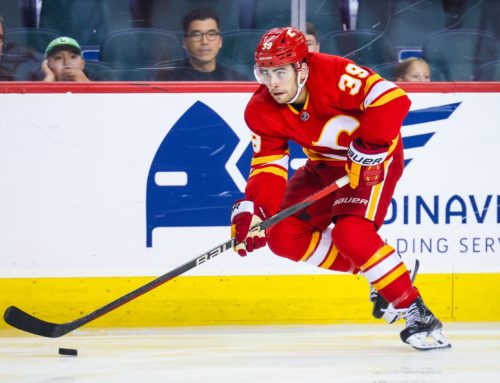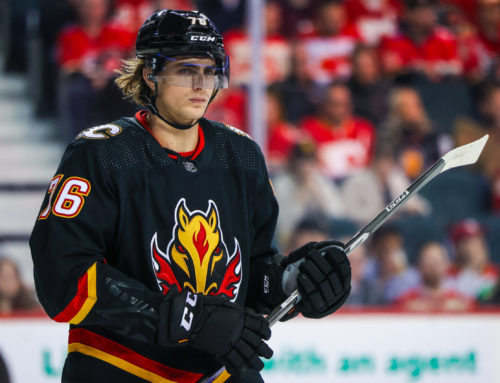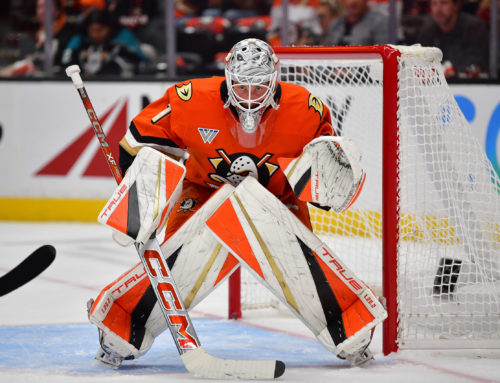Hello everyone, and welcome back to Geek of the Week. In this article, I will be reviewing the goaltender position for multicategory leagues. I will be using the True Value constructs like Quality Weeks (QWs), Really Bad Weeks (RBWs), and Star Weeks (SWs). These goalie stats provide a better picture of goaltender consistency and gauge exactly what goalies have done for their fantasy teams week-in and week-out. They are useful more for multicategory leagues, mainly with the standard categories of Wins, Save Percentage, Goals Against Average, and Shutouts. Here is a recap of how these stats are constructed:
Quality Week (QW) – When a goalie has performed above the weekly average in two out of three of the main goalie categories (Wins, SV%, GAA). Of all goalies this season, the average QW% was 55%.
Star Week (SW) – When a goalie has ranked top 15 for the week in all three of the main goalie categories (Wins, SV%, GAA). OR if your goalie has had a quality week AND has also gotten a shutout (This assumes SO is a counted category). Of all goalies this season, the average SW% was 22%.
Really Bad Week (RBW) – When a goalie has ranked below the top 30 goalies for the week in all three of the main goalie categories (Wins, SV%, GAA), and has not gotten a shutout. These are weeks in which it would have been more valuable for your team to not have the goalie rostered. Of all goalies this season, the average RBW% was 23%.
Rather than looking at the cumulative stats in each category, you can see exactly what value a goalie brought to their fantasy teams each week. The goalies who are more boom or bust are not as valuable as goalies providing consistent value week-in week-out, especially in head-to-head category leagues, where you likely don't need to finish with a .970 save percentage. Although having a stellar week will no doubt lock down the goalie categories for you, a save percentage of .925 will most likely win you that category and others as well. Both of these scenarios would be considered a Quality Week and a likely a Star Week. The Really Bad Weeks are where your goalie has crushed your hopes of winning the goalie categories in a week.
I've compiled rankings of a goalies True Value this season based on z-scores in each of the three mentioned constructs. Here are the top 25, along with the season-ending Yahoo Rank in a standard category league:

Value Goalies
A common trend in these rankings is that volume starters with average rate stats, like Jordan Binnington, Jake Oettinger, Linus Ullmark, and even Samuel Ersson, provided much more value to their fantasy teams than the Yahoo ranking suggests.
Jordan Binnington (28 W, 2.84 GAA, .913 SV%, 3 SO) is one of the largest unsung heroes of this fantasy season for category leagues. His rate stats are pretty average, making his Yahoo ranking of 20 make sense when we only look at the cumulative rate stats. But Binner was insanely consistent this season. He only had 1 RBW all season and came up with a QW 77% of the time. For 20 out of the 26 fantasy weeks, his fantasy managers were not quite amazed, but pleased with his production. You may not have thought so with his cumulative stats, but for a goalie drafted outside of the top 100 in fantasy drafts, Binnington was the steal of the season.
It's time to talk about the Boston goalies. Jeremy Swayman (25 W, 2.53 GAA, .916 SV%, 3 SO) is looked at as more valuable than Linus Ullmark (22 W, 2.57 GAA, .915 SV%, 2 SO) in many fantasy managers minds and in the Yahoo rankings due to Swayman's slightly better cumulative stats and him earning a few more starts (43) than Ullmark (39). I'm here to tell you that in category leagues, Ullmark was the more valuable goalie this season due to his consistency. He had more QWs (20) than Swayman (16) and far fewer RBWs (1 to Swayman's 5). Swayman actually had the second worst RBW% of all goalies within the top 25. Swayman did have two more SWs than Ullmark, but that just points to his boom-bust tendency. If you owned Ullmark, he got a start in every fantasy week and provided a QW in 77% of them with limited poor showings. This trend was similar last year for the Boston goalies. If Boston runs it back with both of them alternating starts again, Ullmark can be a valuable late-round pick next season with most managers expecting Swayman to be Boston's starter.
Backups
One area that interests me greatly is that of true backup goalies providing great value. They are represented highly in the Yahoo rankings due to great cumulative stats. These are guys like Laurent Brossoit (15 W, 2.00 GAA, .927 SV%, 3 SO), Anthony Stolarz (16 W, 2.03 GAA, .925 SV%, 2 SO), David Rittich (13 W, 2.15 GAA, .921 SV%, 3 SO), and Calvin Pickard (12 W, 2.45 GAA, .909, 1 SO). Many of these guys provided great value as streaming options, getting added and dropped throughout the season.
These backups are all a little overvalued in Yahoo's rankings due to their superb cumulative stats, but are still highly represented in the top 25 True Value rankings. These backups are all on very strong teams and thus it gives them the opportunity to pick up QWs most of the time. Is it tenable to roster these backups for the whole season though? When they get starts, they provide value, but if they don't play in a week, you are wasting a roster spot – but are you? That roster spot could have easily been taken up by a highly rostered goalie providing an RBW (like Darcy Kuemper, John Gibson, or Jake Allen), providing negative value to your team.
Brossoit and Stolarz had consistent backup roles for the whole season, earning at least one start in 20 of the 26 fantasy weeks. During these weeks, it was worth rostering and starting them as Brossoit picked up a QW 90% of the time and Stolarz 80% of the time. During the six weeks they didn't play, they at least did not give you any RBWs.
For Rittich and Pickard, they didn't start the season as their teams' true backups, but they earned their roles down the stretch. Rittich only earned a start in 15 fantasy weeks while Pickard earned one in 16. These guys were obviously not worth rostering at the start of the season when they weren't getting any starts, but if you picked them up midway, they would've provided great value if you held onto them. Next season, I may try to target a strong backup on a strong team getting almost a start a week and see if holding onto them season-long is a viable strategy.
Worst Goalies
One area the True Value rankings align with Yahoo's rankings is the bottom of the barrel: the worst goalies this season. These rankings can show just how much these goalies hurt fantasy teams. These goalies should not have been rostered in category leagues.

Darcy Kuemper (13 W, 3.31 GAA, .890 SV%, 1 SO) finished the season rostered in 42% of Yahoo leagues. This number was way higher, around 80% before losing his starting role to Charlie Lindgren. He had almost as many RBWs (7) as QWs (8).
John Gibson (13 W, 3.54 GAA, .888 SV%, 0 SO) finished the season rostered in 28% of leagues. Before injuries crept up on him, he was much more rostered as well. He provided terrible value to teams putting up a QW only 37% of the time, and a RBW 25% of the time.
Joonas Korpisalo (21 W, 3.27 GAA, .890 SV%, 0 SO) finished the season rostered in 50% of leagues. He earned way too many starts for an underwhelming Senators team, finishing with only 9 QWs and a whopping 7 RBWs.
Poor Arvid Soderblom (5 W, 3.92 GAA, .879 SV%, 0 SO) takes home the crown for worst fantasy goalie of the season. Luckily, he was only rostered in 4% of fantasy leagues to finish the season, and hopefully no category leagues. He had a RBW 56% of the time, while only providing value with a QW 26% of the time.
Highly Drafted Disappointments
Here I'm going to highlight goalies that were drafted early on in fantasy drafts that did not provide value. These were wastes of draft picks and might have turned a few managers onto a ZeroG strategy. Below are the True Value Rankings from 26th to 50th.

Ilya Sorokin (25 W, 3.01 GAA, .908 SV%, 2 SO) was drafted as the 2nd goalie taken on average in fantasy drafts. He has been known to be a boom-or-bust goalie in previous seasons, relying heavily on SWs to provide value. This year, he really leaned into that and disappointed fantasy managers, picking up a QW only 60% of the time, but this year his SWs were missing, picking up only 3, only as many as his RBWs. Sorokin may have been better on your bench or waivers than on your fantasy team, a real disappointment for a 2-4th round pick.
Andrei Vasilevskiy (30 W, 2.90 GAA, .900 SV%, 2 SO) was drafted as the 5th goalie taken on average in fantasy drafts. Even missing the start of the season, 30 wins is impressive, but Vasilevskiy lost his consistency this season. He provided a QW only 50% of the time and didn't pick up many SWs to make up for the lack of consistency.
Ilya Samsonov (23 W, 3.13 GAA, .890 SV%, 3 SO) was drafted as the 12th goalie taken on average in fantasy drafts. He had a whopping 7 RBWs, tied for 4th most in the league. He only picked up a QW 42% of the time. He had a few good stretches, picking up a nice number of SWs with 6. But his terrible stretches outweighed his good stretches. Teams who held onto him would have had negative value from a high draft pick.
Zero Goalie Strategy
The goalies above, which provided negative value to teams, took up a high draft pick that could have been used on a consistent valuable top 50 skater. This is the tenet of a Zero Goalie strategy. Some swear by this strategy and usually won't take a goalie within the first 10 rounds. With this strategy, you likely would not be taking a goalie until the 15th-20th goalie off the board. Your team focuses on skater categories, while hoping to stream in the goalie categories.
The counter argument is the success and top 10 finishes of Connor Hellebuyck, Sergei Bobrovsky, Igor Shesterkin, Jake Oettinger, and Linus Ullmark. If you can draft a goalie within the top 12 taken, getting top 10 value for you is a win in my books. These five goalies would have been set and forget goalies, providing great value for your teams most of the time (around 75%). Though, of the top 12 goalies drafted, only 5 (the goalies named above) finished in the top 10. 2 of them provided negative value (Samsonov and Gustavsson), while the other 5 (Sorokin, Vasilevskiy, Saros, Georgiev, Swayman) were similar value to streaming options.
But if you wait until the end of the draft, you miss out on volume starters and have to resort to streaming and the waiver wire to get your value. A strategy this year may have looked like starting with Cam Talbot and Jonas Johansson, then moving onto Connor Ingram and David Rittich. Maybe Ukko-Pekka Luukkonen or Joey Daccord made it onto those teams. But who's to say that you are properly going to hold these guys when they're on, providing QWs, and dropping them before they run out of fire, avoiding those RBWs? It could have just so happened that you pick up Daccord a little late into his hot streak, and stream one of his RBWs instead of getting proper value for him. If you held onto Ingram all season, you would've experienced his 6 RBWs. He would have been worse than Sorokin and Vasilevskiy. That is fine if you didn't have to invest any draft capital, but your team is still losing goalie categories.
It seems as though most of the highly drafted goalies are still represented in the top 30 of the True Value Goalie Rankings, even goalies that seem to have disappointed greatly like Alexandar Georgiev, Tristan Jarry, and Jacob Markstrom. If you spend draft capital on a goalie, they will still likely provide some positive value to your team. However, if you don't invest any draft capital and focus that on skaters, you can still likely get positive value.
The point of ZeroG is to focus on skater categories, but I am curious as to whether this strategy is actually better for the goalie categories (ignoring skater categories), given the inconsistency of top-end goalies. So, I am calling out to the community to reach out to me if you employed a ZeroG strategy in a category league and think you got great value. If you provide me with your goalie adds and drops with dates, I'll take a look and see just how much your strategy resulted in QWs, SWs, and RBWs. We can then see exactly where that strategy ranks in the True Value Goalie Rankings.
I will likely continue to employ a ZeroG approach next season, but I would love to compare the rankings of a specific add/drop strategy. Please reach out on X! You can follow me on X @fantasycheddar, where I will answer any questions you may have.





 FLA
FLA CHI
CHI NYR
NYR PIT
PIT L.A
L.A COL
COL BUF
BUF UTA
UTA PHI
PHI STL
STL VAN
VAN CBJ
CBJ N.J
N.J
